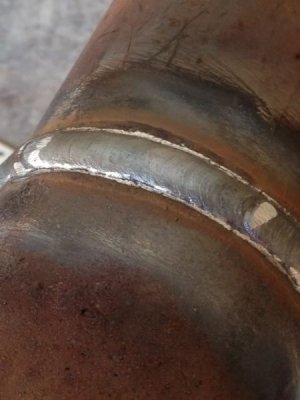-
Welcome back Guest! Did you know you can mentor other members here at H-M? If not, please check out our Relaunch of Hobby Machinist Mentoring Program!
You are using an out of date browser. It may not display this or other websites correctly.
You should upgrade or use an alternative browser.
You should upgrade or use an alternative browser.
Porosity With Tig On Mild Steel.
- Thread starter savarin
- Start date
- Joined
- Dec 6, 2012
- Messages
- 2,677
I usually try to grind a taper approximately 2.5 x the diameter.
Very approximate....
Jayvilles point about filler rod is valid, if you aren't using good fillers.
Old coat hangers may work ok for OA. But, TIG needs good stuff.
Check your travel angle....
Daryl
MN
Very approximate....
Jayvilles point about filler rod is valid, if you aren't using good fillers.
Old coat hangers may work ok for OA. But, TIG needs good stuff.
Check your travel angle....
Daryl
MN
- Joined
- Feb 26, 2014
- Messages
- 171
The comment about using stainless steel filler wire is a good one. I should have mentioned that. That is a boilermakers trick. Stainless steel filler rod will eliminate porosity due to surface prep and contaminates but not gas issues!
- Joined
- Mar 12, 2014
- Messages
- 1,531
I think your culprit is the mill scale. TIG welding does not play well with the scale.
You could try some 309 or even some 308 S/S wire but plain ole ER70S-2 should work fine as long as the metal is bare and clean. I am not a fan of using S/S wire to mask an underlying issue, I use it where the weld or specs call for it.
Mike.
You could try some 309 or even some 308 S/S wire but plain ole ER70S-2 should work fine as long as the metal is bare and clean. I am not a fan of using S/S wire to mask an underlying issue, I use it where the weld or specs call for it.
Mike.
- Joined
- Feb 26, 2014
- Messages
- 171
Yes you can use MIG wire but it's probably .035? I think you will find that with filler wire of that diameter you will have issues of it wanting to burn back and ball up before you get it in the weld pool. But it is a very good option for small detailed welds on thin small things if that makes sense. Tungsten condition will be more important. Sharp point and frequent touch ups if the end gets dirty from contact with the weld pool. Also you may find a smaller more focused arc with 3/32" tungsten vs 1/8" but really shouldn't make much difference.
For sharpening tungsten it's hard to beat a drill and grinding wheel. Often it's done in the field on a hand held 4 1/2" grinder although there is usually a bench grinder out side the tool room. At home I have cut and removed a portion of the bench grinder guard on the back so I can grind with the rotation of the wheel vs on the front where the wheel first contacts the tip. Seems to give a better finish and tip.
While Mike talks about masking an underlying issue that's true. But when I need to make a tool to shut the city water off in the front yard I'm not going to clean everything down to bright shiny metal. I'm not welding pipe at the Savannah River nuclear site anymore. I'll use ss 308 or 316 filler.
Most codes allow filler metal of a higher grade than the base metal to be used. Is there a difference between ER70 and 316l? Sure. Does it matter? I'm going out on a limb and say probably not. I've had this conversation with weld inspectors and engineers several times trying to find out for my own benefit. But match the filler to your base metal and use the ss on carbon tip if you need to! Just as important for frustration welding is to match your wire size to what you are doing. 3/32" is probably more useful to us than 1/8" is due to the fact that our stuff is thin and small. Lol
For sharpening tungsten it's hard to beat a drill and grinding wheel. Often it's done in the field on a hand held 4 1/2" grinder although there is usually a bench grinder out side the tool room. At home I have cut and removed a portion of the bench grinder guard on the back so I can grind with the rotation of the wheel vs on the front where the wheel first contacts the tip. Seems to give a better finish and tip.
While Mike talks about masking an underlying issue that's true. But when I need to make a tool to shut the city water off in the front yard I'm not going to clean everything down to bright shiny metal. I'm not welding pipe at the Savannah River nuclear site anymore. I'll use ss 308 or 316 filler.
Most codes allow filler metal of a higher grade than the base metal to be used. Is there a difference between ER70 and 316l? Sure. Does it matter? I'm going out on a limb and say probably not. I've had this conversation with weld inspectors and engineers several times trying to find out for my own benefit. But match the filler to your base metal and use the ss on carbon tip if you need to! Just as important for frustration welding is to match your wire size to what you are doing. 3/32" is probably more useful to us than 1/8" is due to the fact that our stuff is thin and small. Lol
Last edited:
- Joined
- Feb 26, 2014
- Messages
- 171
 I don't want to give the impression that I half a$$ things. When I built my gantry crane in the garage I followed every industry standard that applied for the work I was doing. Full penetration, open root, X-ray quality(or better) welds. I keep a rod oven plugged in with 7018 rods etc. it's been on for 8 years. Hate to think what that has cost.
I don't want to give the impression that I half a$$ things. When I built my gantry crane in the garage I followed every industry standard that applied for the work I was doing. Full penetration, open root, X-ray quality(or better) welds. I keep a rod oven plugged in with 7018 rods etc. it's been on for 8 years. Hate to think what that has cost.

